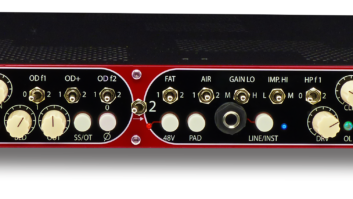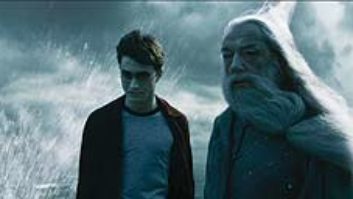Expressing a boundless passion for the recording craft, a unique design aesthetic and uncompromising standards for electronics and acoustics, Al Fierstein does not give off the impression of a man who entered the studio business by accident. But Fierstein — who built Sorcerer Sound in 1974 — never intended for the facility to serve as a stand-alone recording venue; he merely wanted it to showcase his burgeoning equipment design and acoustics consulting businesses.
At the time, Fierstein was doing freelance maintenance for such heavyweight New York studios as Electric Lady and moonlighting as an equipment inventor. Because he wanted to build a device that would measure reverberation time, Fierstein needed a room in which to test his prototypes.
“I’d read up on acoustics and knew that if you wanted to build a good studio, you had to measure the reverberation time at different frequencies,” Fierstein recalls. “There was a measuring device that was reasonably inexpensive, but it was a little too much for my budget, so I designed one, built it and used it for my room. Then, [studio architect] John Storyk heard about it through a mutual friend and suggested some changes for one that would be rackmounted. So I made a rackmounted version for Storyk and then decided to market the product, since it was already on circuit boards.”
In 1976, buoyed by the success of his reverb tester and his growing consultancy business, Fierstein founded Acoustilog, a multifaceted company that integrated acoustics consulting, custom equipment design and manufacture, gear rental, maintenance and the Sorcerer recording studio. A generation later, Sorcerer and Acoustilog continue to flourish together, despite the massive changes wrought on the industry by MIDI, MDMs and DAWs — not to mention the economic ups and downs that have taken a serious, sometimes fatal, toll on other New York studios.
The studio gathered momentum soon after it opened, attracting a clutch of hip artists including the Bush Tetras, Sonic Youth, Steve Forbert and David Byrne. Many up-and-coming acts were also exposed to Sorcerer thanks to the studio’s association with the Radio France live show “Feedback.” The New York correspondent for Radio France, Jean-François Vallée, served as the MC, and Sorcerer was the studio from which it was broadcast over a 15kHz telephone line.
“People like John Zorn and David Byrne were coming by, and this was before they were well-known,” recalls Fierstein. “Sometimes, we recorded them for broadcast; other times, they performed live. Sometimes, we’d set them up on the roof of the building so that the listeners in France could hear the ambience of New York, complete with sirens and street noises.”
As Studio A expanded and Studio B was built in 1984 in the basement of the building — which Fierstein owns — Sorcerer’s fortunes continued to grow. Throughout the ’80s, ’90s and the current decade, it has entertained clients across a wide spectrum of music styles, including rock, R&B, Latin, gospel, hip hop and jazz.
Today, Sorcerer is a grown-up version of its former self. The sprawling Studio B features a 62-input, GML-automated Neve built from two vintage boards: a 32-input 8068 from the legendary A&R Studios in New York, and a custom 30-input console from Studio D at George Martin’s AIR Studios in London. Fierstein streamlined and modified the consoles so that they would function as one continuous board, added the automation and joined them in a V-shaped arrangement (one of his design hallmarks) because “it’s a good idea to locate the engineer at the center of the room.”
The console also features Acoustilog’s Spectrum Multilyzer, a spectrum analyzer with peak and average meters that are superimposed on the same scale. The Multilyzer allows engineers to maximize the dynamic range of their recordings by setting nonpeaking sources, such as distorted electric guitars and Hammond organs, as high as +14 dB, and high-transient instruments like pianos and triangles much lower.
“We get calls from other studios saying, ‘How come this track is way off the top on the machine? It looks totally distorted.’ I say, ‘Does it sound distorted?’ And they say, ‘Well, no, it doesn’t sound distorted, but how would you know? It’s off the meters.’ And I say, ‘Your VU meters only go to +3 dB. The way you know is because it sounds clean.’”
If Sorcerer’s custom electronics reflect Fierstein’s purist approach toward equipment design, the layout of the console, speakers, outboard gear and tape machines evince a clear sense of ergonomics and a sensitivity to engineers’ and recording artists’ needs. Everything in Studio B’s control room is mobile, including the outboard racks and the 3,000-pound console, which is set on tracks.
“The reason for the Siamese-twin Neves being on tracks is to allow clients to sit in front of the console, as is customary during tracking, or behind the console during mixing without wasting space in either location,” says Fierstein.
Studio B also features custom Gauss co-ax monitors, designed in-house and protected by Acoustilog’s POP-110 peak-overload protector. “It’s basically a peak-responding limiter with boosted high-frequency sensitivity to compensate for the lower level of treble in most music,” says Fierstein. “The POP-110 mutes the speakers for one second if the monitor volume exceeds the preset threshold. Nothing blows; nothing has to be reset, but the sound resembles a giant hiccup. After hearing it once, most engineers turn it down a few dB, and it never happens again. The main difference between the POP-110 and a limiter is that there are no relays or active components in the signal path during normal operation, only when the system is muted. I laugh when I hear about how studio owners are glad they only blow one speaker a week.”
The Neves’ monitoring section is another of Fierstein’s ingenuities: It features a milled-aluminum slot lined with photocells that soundlessly adjust the level in 10dB increments. It also has precision stereo VCAs, which provide a left-right balance accuracy that Fierstein says is unavailable in most consoles’ monitor pot.
While many studio owners are content to leave “vintage” gear alone, Fierstein is an irrepressible tinker who loves to improve upon a design. His LA-2As have all been rigged with in/out switches, metering of both the input and output levels in addition to the gain reduction, and a 20dB-lower noise level. Similarly, the extra parts from the two Neve consoles have been refashioned.
“We used the extra transformers to make multichannel Neve direct boxes, which are built into the patchbay and available in both studios,” Fierstein explains. “We’ve also sold them to other studios. But the best Neve mod was the series of changes that minimize the signal path while providing full-functioning normal and remix modes on the whole console. This provides a significant side benefit: reduced maintenance, since there are fewer contact points and more redundant relay contacts. Since I do the maintenance myself, I do everything I can to increase the studio’s overall reliability.”
Unlike studio owners who pay a premium for their vintage gear, Fierstein got his from bartering services years ago, when the tube equipment was temporarily out of favor. He got Pultecs from a 4-track studio in exchange for wiring it up, and six Neumann U47s from George Adams’ widow, whose United Recording Labs was one of Fierstein’s early hangouts.
“In 1972, one of my customers gave me an old junky tube limiter that I decided wasn’t worth the continual maintenance on it, what with the 15 or so tubes in it,” says Fierstein. “So I just threw it out. It was a Fairchild 670 Stereo. But I kept the Pultecs.”
Fierstein is no less attentive to his acoustics than he is to his electronics. Eight large rotating panels in the vast, 25-foot-high tracking area in Studio B can totally change the sound in the upper half of the room, where most of the ambient miking is done.
“Most engineers love the idea of being able to vary the room sound,” says Fierstein. “But when Lou Reed was looking to do his album at Sorcerer, he took one look at the panels, which are controlled by Radio Shack antenna rotators, and decided that there were ‘too many possibilities’ to record there.”
Other acoustical features include a drum booth with a 100-year-old stone wall, a dead iso booth and a sound lock equipped with mouse holes that allow wiring to be run in and out.
While Studio B — the larger and newer of Sorcerer’s two rooms — represents the pinnacle of Fierstein’s skill as a designer and builder of recording spaces, the original Studio A reflects his original vision for a funky, cool downtown studio that serves as a demo room for his hardware products.
Studio A started out as a small 8-track space in 1975, and over the years has evolved into a respectable mixing/tracking/overdubbing facility with a comfortable — if cozy — control room and four isolated spaces that permit the tracking of up to six players. Studio A features a 32-input Acoustilog GB-1 console, also arranged in Fierstein’s trademark “V” shape and equipped with Optifile 3-D automation. Other amenitites include a Multilyzer and a hydraulic lift that houses extra cue sends.
“We have a lot of custom features — a lot of stuff you won’t find in other studios,” says Fierstein, who started out as an electronics hobbyist and drummer. “We emphasize the acoustical space and the equipment. We’re not the type of place that gives you fresh flowers every day. It’s not designed to be a health spa or a catering hall.”
Not that anyone would mistake Sorcerer for either of the above. When clients arrive at the studio, they enter through industrial metal doors found in most downtown New York lofts. In the lounge, however, Sorcerer’s loft-like aura gives way to an atmosphere more typical of a zoo or natural history museum than a recording studio. A vast collection of insects is displayed on the walls. A live tarantula and snapping turtle occupy cages above a pool table. A huge python lives in the space between the dual-glass window that separates Studio B’s control room from its tracking area.
“The lounge is always fun for the musicians when they’re on a break,” says Fierstein. “They like to play pool and feed Samantha the snake, who eats rats. It’s educational; it gives them an appreciation of nature — just like watching Ike the tarantula and Tommy the turtle.”
Some clients find Sorcerer’s ambience macabre. Suzanne Vega, who is a Buddhist, did not like the vibe of all the dead animals, according to Fierstein. The “fuzzy ones,” like the deer head, were more upsetting to her than the Goliath beetle, he says. Similarly, a gangsta rapper asked the studio staff to cover all of the tarantulas, including a dead one mounted in the lounge lunch table, with paper. (“Some of those guys aren’t as tough as they come across on record,” observes Fierstein.)
But most musicians love Sorcerer’s menagerie. Keith Richards, while working on a Johnnie Johnson album, fashioned a ring out of aluminum foil for George, the human skeleton who lives in the bathroom.
“We used to have a fake human hand that would pick up the phone on the producer’s desk and hand it to the client, along with a human thumb to select the incoming phone line, until someone decided to shake hands with it one day and bent the mechanism,” says Fierstein with a touch of nostalgia.
It matters little to Fierstein whether Sorcerer’s impossibly diverse clientele — from Bob Dylan to De La Soul to Tom Verlaine, from Iggy Pop to Miles Davis to Pussy Galore — has kept coming back to the studio because of its unique ambience, its superb acoustics or its venerable collection of customized gear (to which Verlaine, the first client in Studio B, has contributed many rare pieces). The point is the business has thrived even in the most uncertain conditions.
Recently, in the aftermath of the September 11 terrorist attacks in New York and, a rumor circulated that Sorcerer was closed — a rumor erroneously reported by this writer in Mix. Fierstein refutes the rumor and says Sorcerer is as healthy as ever. He adds, however, that he has floated the idea of selling part of the studio, which may explain how the rumor got started.
“Selling part of Sorcerer is a possibility,” says Fierstein. “But I would hate to see it turned into a store. With 9/11 and the unpredictable real estate market in New York, who knows what will happen. What I do know is that Sorcerer will run as long as there are clients and enough business to keep it going. I still use the studio a lot as an acoustics demonstration room, which is what it was always intended to be.”



